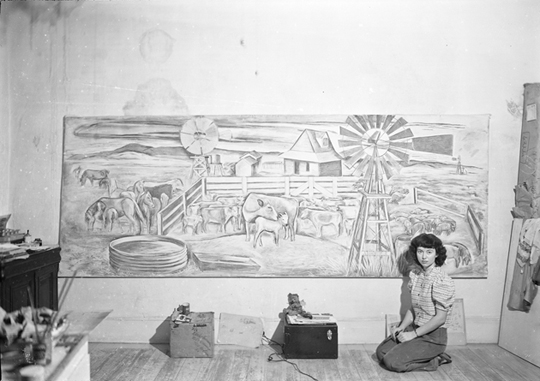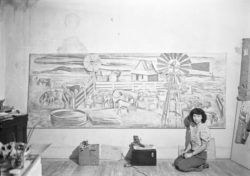Ethel Edwards
New Orleans born painter and instructor Ethel Edwards is known for her large-scale murals created during the New Deal era.

Courtesy of The Historic New Orleans Collection
Ethel Edwards with Xavier Gonzalez mural. Leyrer, Daniel S. (photographer)
As a young woman, New Orleans born painter and instructor Ethel Edwards attended H. Sophie Newcomb College in New Orleans, where she studied art under teacher, artist, and future husband Xavier Gonzalez (1898–1993). Edwards, who exhibited often at the Arts and Crafts Club of New Orleans, became known for her large-scale murals created during the New Deal era. She worked with various artistic media, including collages using Japanese black ink and colored rice paper, a technique directly influenced by her early travels to Asia.
Edwards was born in Opelousas, Louisiana, in 1914 and moved with her family to New Orleans in 1923. She resisted her father’s attempt to enroll her in a secretarial school following her high school graduation, and instead obtained a scholarship to attend Newcomb College, where, in September 1935, she studied watercolor, portrait, and life drawing with Gonzalez. The couple married the following summer in Alpine, Texas, where Gonzalez directed an artists’ colony. Edwards traveled to Paris in 1937–38. In 1939, the young artist won the Forty-Eight State Mural Competition in Lampasas, Texas, organized as part of the New Deal Program (1934 to 1943). Her mural, Afternoon on a Texas Ranch, was featured in a post office in Lampasas until it was moved to City Hall in 2002. She was also commissioned to paint a mural for a post office in Lake Providence, Louisiana, in 1939 as part of the same competition.
Edwards’s work was shown locally in New Orleans during the 1930s. In 1939, her work was exhibited at the thriving Arts and Crafts Club at 712 Royal Street, along with the work of other artists’ wives, including Jane Smith Ninas and Helen Vance. In a review for the show published in the Times-Picayune on March 26, 1939, the critic Edith Norris wrote that Edwards “seems to look through a mystic twilight which gives subdued modulations to her color and softens the outlines.…” The review highlighted several paintings by Edwards, including a self-portrait in shades of grays and blues, and the landscape painting Alpine.
Edwards moved with her husband to New York in 1942, where they kept separate studios. Edwards completed fashion illustrations that were featured in Town and County and Fortune in the mid-1940s, and her illustrations for Oscar Wilde’s play The Happy Prince were shown at the Museum of Modern Art in 1946. In addition to teaching at the Art Students League for many years, as did Gonzales, Edwards worked in Cape Cod, Massachusetts. The couple spent summers in Wellfleet, Massachusetts, where she taught at Gonzalez’s Wellfleet Art School.
Edwards exhibited at prominent museums and galleries, including the Whitney Museum of American Art and the National Academy of Design. She was a member of the American Watercolor Society, Truro Center for the Arts in Massachusetts, and the Rio Grande Artists Group. Edwards remained in New York City and died there on January 24, 1999. In her Times-Picayune obituary, she was remembered as “an artist for all seasons, full of warmth and with an intense discipline to create.” Edwards’s papers, reflecting her time as an artist in both New Orleans and New York, include photographs and numerous sketchbooks, which are in the holdings of the Smithsonian Institution in Washington, D.C.
